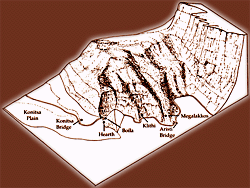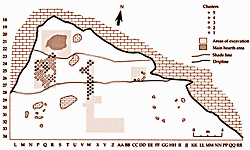


 The Kleidi rockshelter lies in northwestern Epirus, in the valley of
the Voidomatis river (Vikos gorge) and is the largest known rockshelter
in Epirus to date. It is situated at a height of approximately 500 metres,
30 metres above the present flow of the Voidomatis river.
The Kleidi rockshelter lies in northwestern Epirus, in the valley of
the Voidomatis river (Vikos gorge) and is the largest known rockshelter
in Epirus to date. It is situated at a height of approximately 500 metres,
30 metres above the present flow of the Voidomatis river.
The layers of a thickness ranging from 2,8 to 7,0 metres confirm the use of the rockshelter during the last Glaciation, between 16,000 and 10,000 BP, which corresponds to the last phases of the Upper Palaeolithic. These layers have attracted a great deal of interest with the discovery of a large hearth, situated in the better protected part of the rockshelter, and the large quantity of finds that were unearthed. The number of bone and lithic artefacts in particular was as high as 160,000 per cubic metre.

A study of the distribution of the finds in the part of the rockshelter
which has been excavated has lead to the following conclusions:
1. The area around the hearth was vital to the occupants of the rockshelter
for manufacturing tools, preparing and consuming food
(animal bones), but also for resting and sleeping.
2. The areas further from the hearth were probably used for the manufacture
of tools (products of the different manufacturing phases of lithic tools)
and for the disposal of waste and food remains.
3. The rockshelter Kleidi was used as a seasonal refuge for a small
group of hunter-gatherers.
The Kleidi site forms a part of the palaeoenviroment of the Voidomatis valley and provides important information on the economic exploitation of the area. In the mean time, that means during the 14th millenium BP, the Boila and Megalakkos rockshelters were also in use. It seems, however, that Kleidi was a centre of economic activity for the period 16,000-13,000 BP.
The Kleidi rockshelter was first discovered in 1979, but excavations were conducted between 1983 and 1988 by a team of the British Archaeological School in Greece under the supervision of Professor G. Bailey. This phase of the excavations followed the innovative surveys of E.S Higgs in Epirus in the 60's.